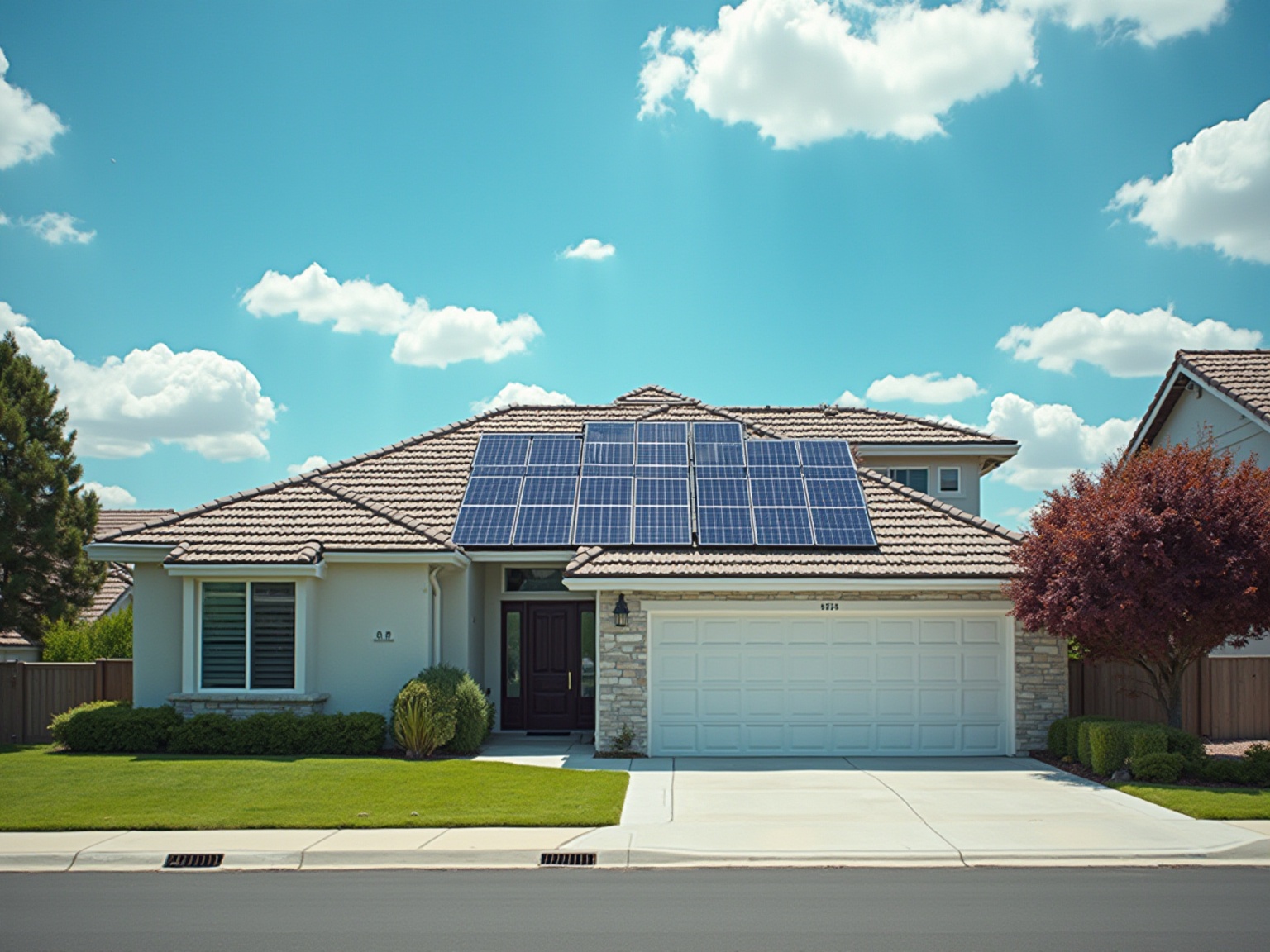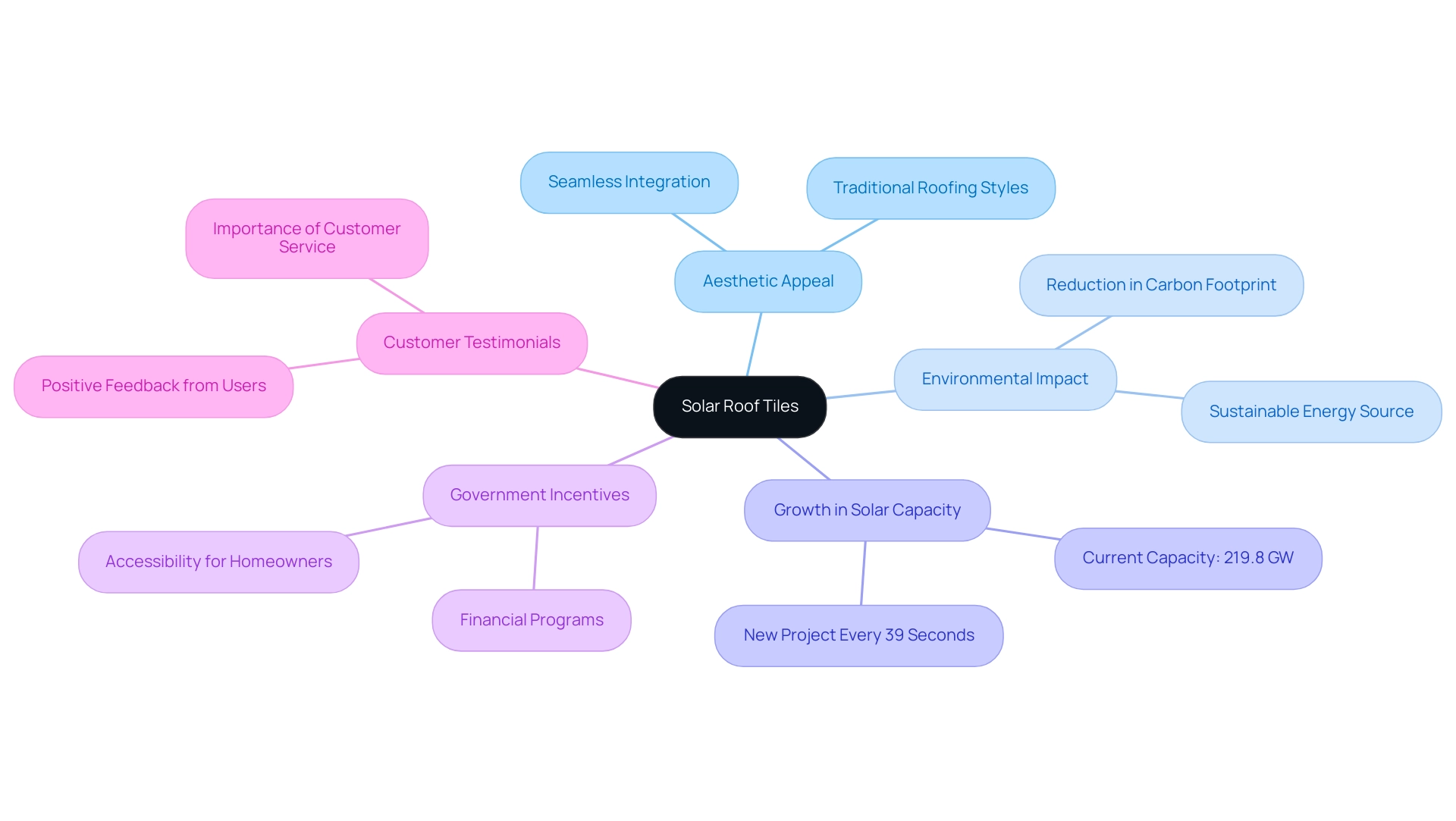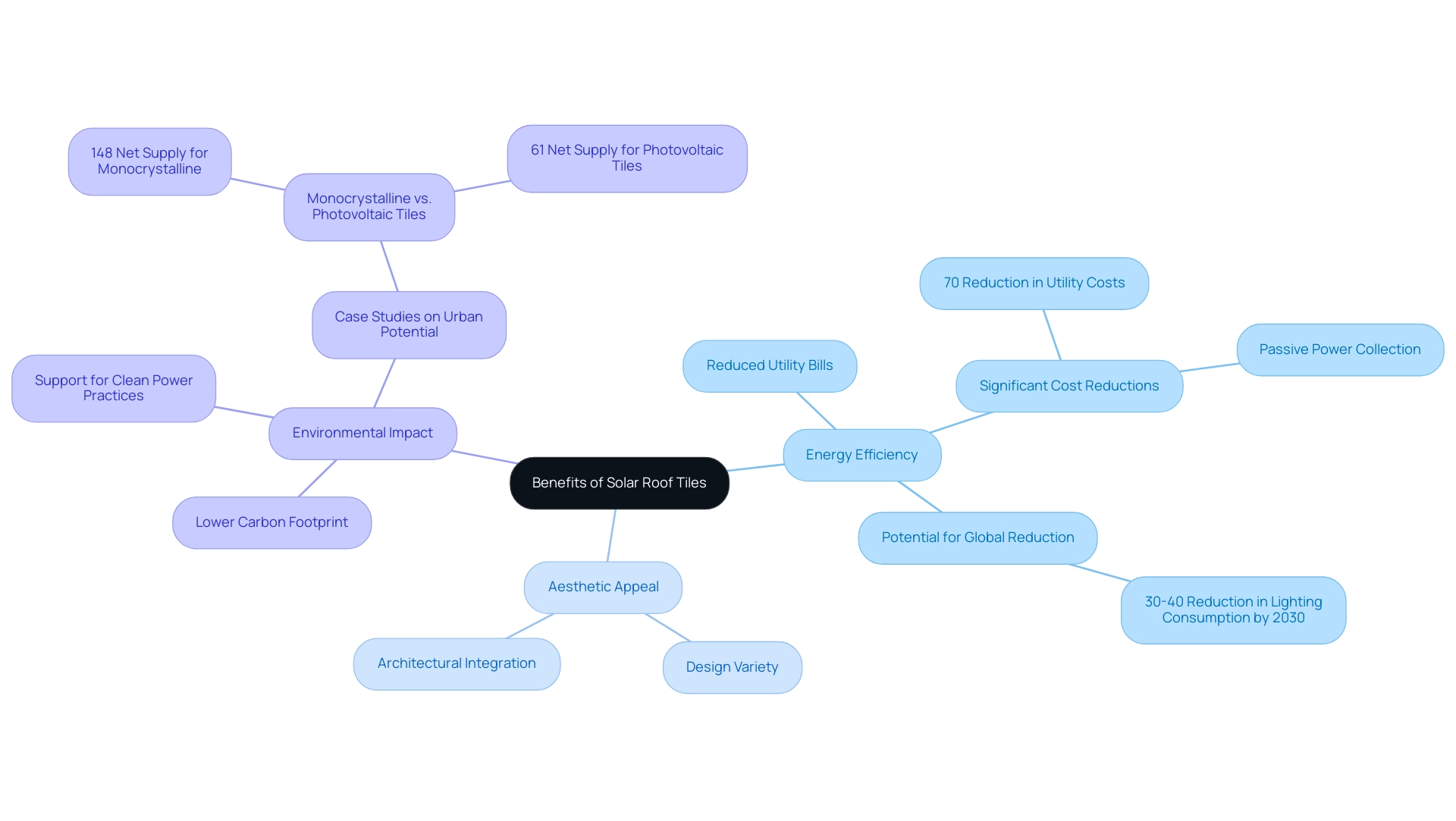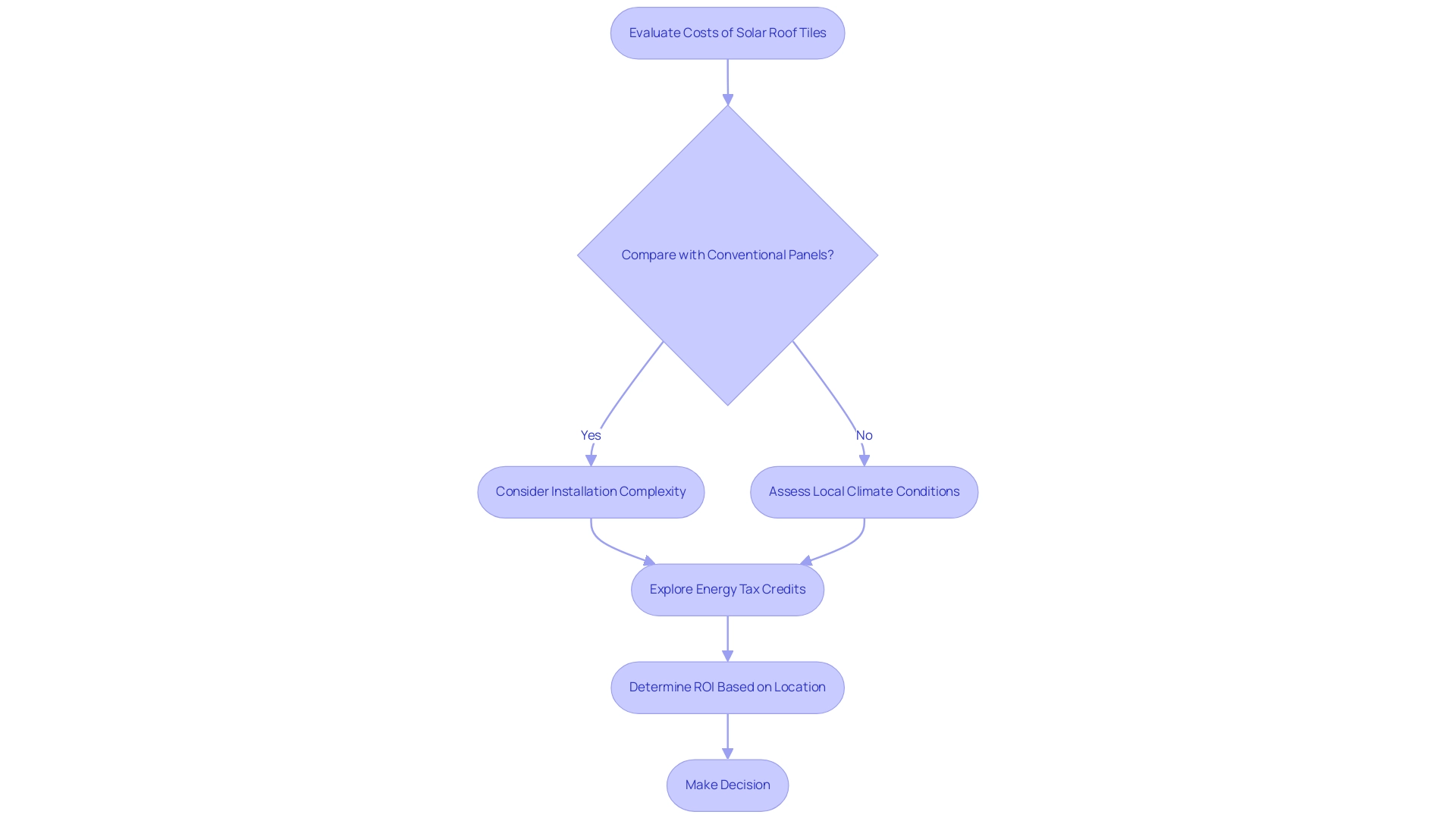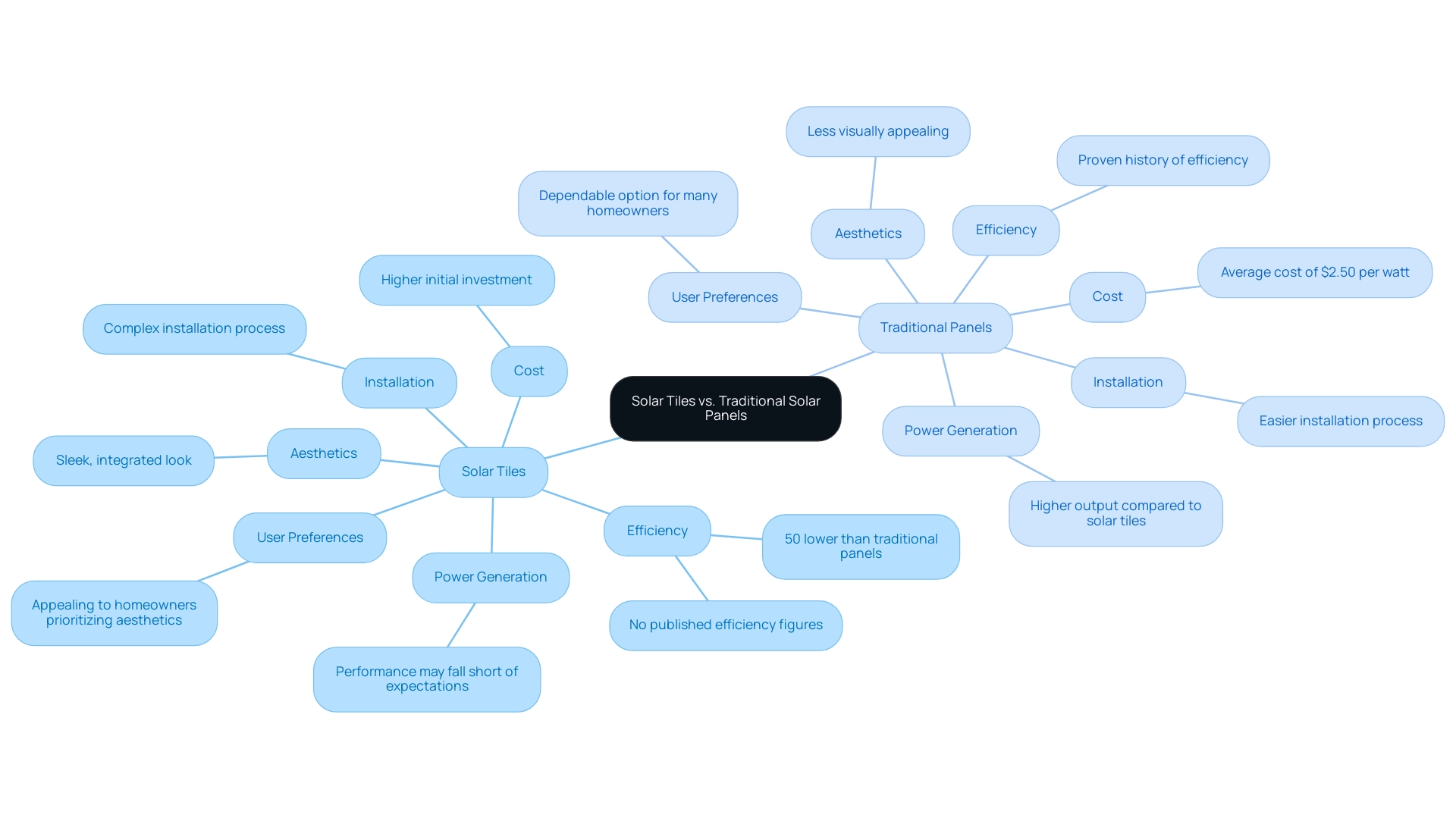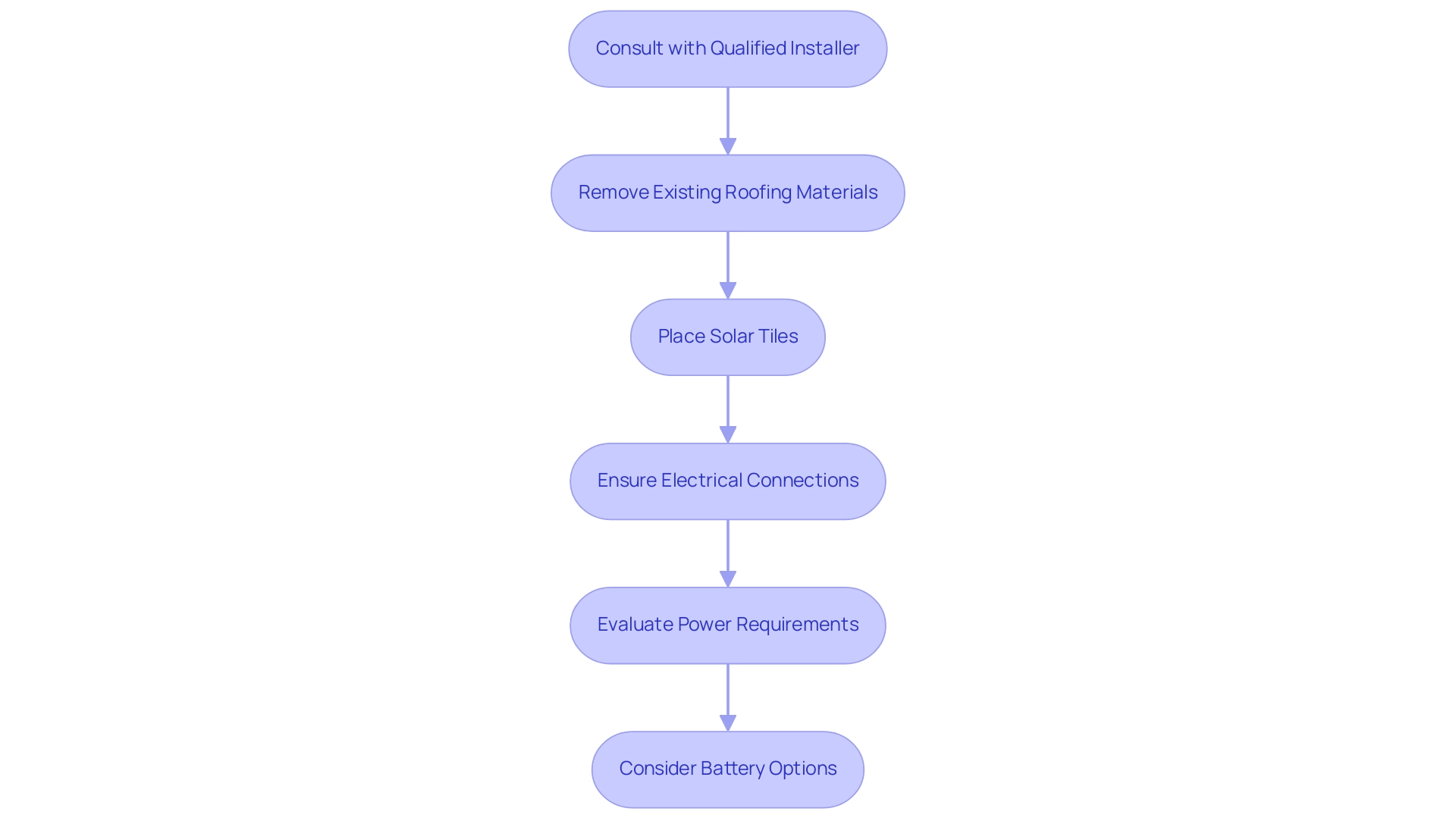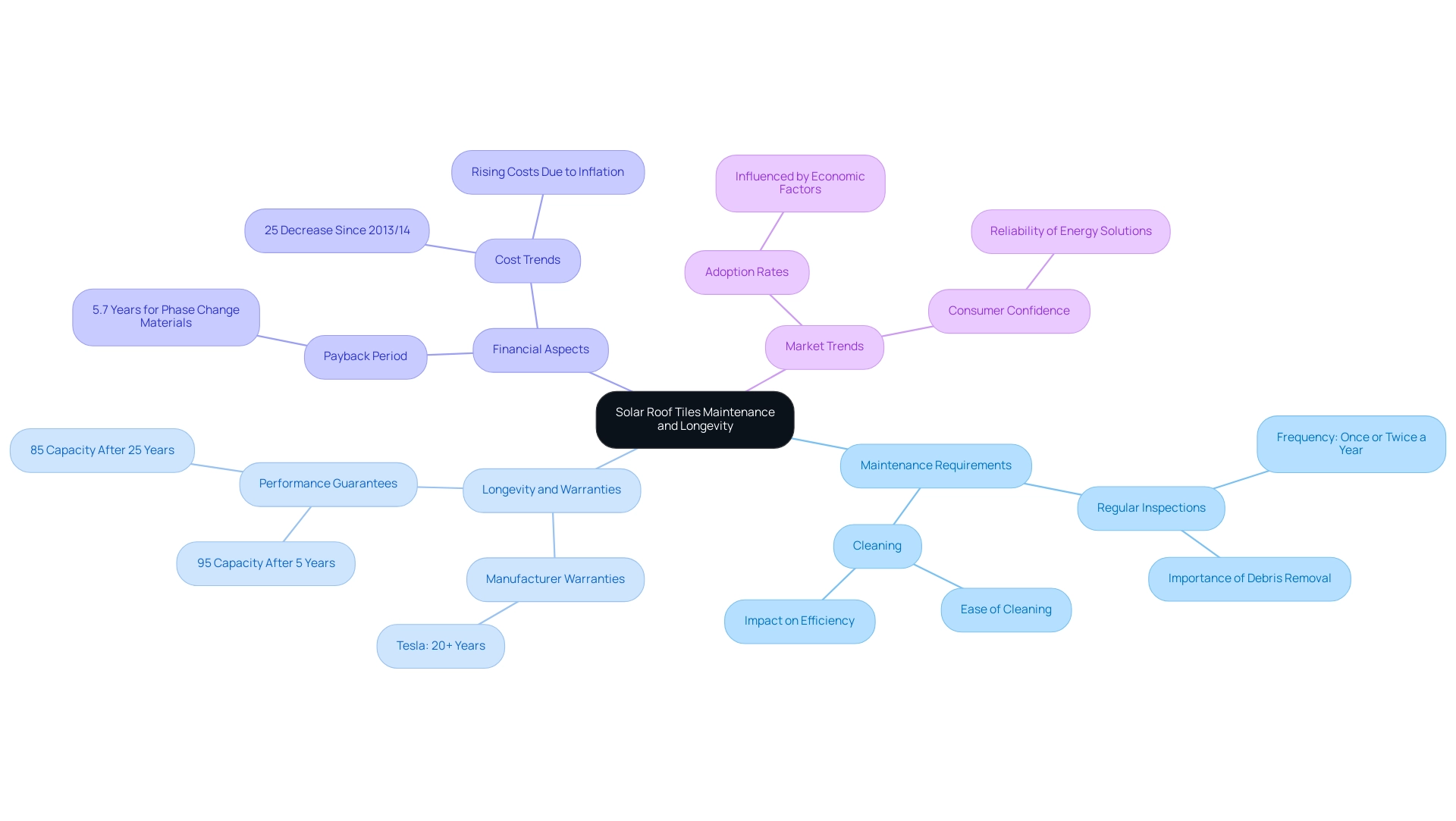Overview
Solar tiles for roofs, also known as photovoltaic shingles, are innovative roofing materials that convert sunlight into electricity while maintaining aesthetic appeal, making them a popular choice among environmentally conscious homeowners. The article highlights their benefits, including energy efficiency, reduced utility costs, and the ability to integrate seamlessly into traditional roofing styles, all of which contribute to their growing adoption in the renewable energy market.
Introduction
As homeowners increasingly seek sustainable solutions to reduce their energy bills and environmental impact, solar roof tiles are emerging as a compelling choice. These innovative shingles not only harness the sun’s power to generate electricity but do so while seamlessly blending with traditional roofing styles, allowing homeowners to maintain their property’s aesthetic appeal.
With the solar industry booming and more installations occurring every minute, many are discovering the significant benefits of switching to this eco-friendly alternative. From impressive energy savings to the potential for government incentives, solar roof tiles represent a forward-thinking investment that aligns with both personal and planetary well-being.
This article delves into the technology behind solar roof tiles, their benefits and challenges, and what homeowners need to know to make an informed decision about this exciting energy solution.
Introduction to Solar Roof Tiles: Definition and Overview
Photovoltaic tiles, commonly known as solar shingles, are an innovative option for environmentally aware homeowners aiming to use solar tiles for roof to positively influence their power usage. These innovative roofing materials, such as solar tiles for roof, integrate photovoltaic technology to convert sunlight into electricity while harmonizing beautifully with traditional roofing styles. Unlike conventional solar tiles for roof that sit atop your roof, shingles blend in seamlessly, offering a perfect marriage of functionality and aesthetic appeal.
This means you can enjoy the advantages of utilizing sunlight without compromising your home’s aesthetics. With a new energy project being installed every 39 seconds in 2023, more homeowners are embracing this sustainable option. At present, the photovoltaic capacity in the US is at an impressive 219.8 GW, demonstrating the swift expansion of renewable power adoption.
Solar panels not only satisfy your household energy requirements but also aid in creating a more eco-friendly planet, making them an attractive option for individuals seeking to improve their energy efficiency while fostering sustainability. Many homeowners can also take advantage of government panel programs that offer financial incentives, making the switch to renewable energy even more accessible. Customers like Ryan, who praised Powercore Electric for their fast, efficient service, highlight the importance of a customer-first approach in this growing industry.
As Ryan noted, ‘I have referred Powercore to some friends and they were also happy with their service.’ Powercore Electric, a trusted local provider with 30 years of service in California, continues to lead with unmatched quality craftsmanship and community commitment. The future appears promising for homeowners contemplating solar tiles for roof as an energy-efficient option.
As we look ahead to 2024, the focus on expanding solar technology into low-income areas shows a broader acceptance, ensuring that sustainable energy solutions are accessible to all.
How Solar Roof Tiles Work: The Technology Behind the Energy
Solar tiles for roof are a groundbreaking solution that captures the sun’s energy to produce electricity directly from your home. Each piece is equipped with photovoltaic cells that come to life when sunlight hits them, exciting electrons and creating a flow of electricity. This electricity starts as direct current (DC) but don’t worry—an inverter transforms it into alternating current (AC), seamlessly powering your home appliances.
With climate change being a pressing issue, it’s crucial to adopt renewable energy solutions such as solar tiles for roof installations. These slabs are capable of performing even in partial shade, making them a versatile choice for different roofing situations. They easily connect to your existing electrical systems, reducing your reliance on the grid and lowering your electricity bills.
Additionally, the PV industry is creating job opportunities, with women constituting 40% of the workforce as of 2021, showcasing the diversity in this growing sector. Not only do solar tiles for roof provide clean power and help in reducing greenhouse gas emissions, but they also enhance the appearance of your home, especially with Building Integrated PV (BIPV) technologies that replace traditional materials. This blend of functionality and design makes solar tiles for roof an attractive option for environmentally aware homeowners, promoting both sustainability and energy autonomy.
It’s important to consider the distinctions between active and passive heating methods when selecting a system. Active systems, which use pumps and controls to circulate heat transfer fluids, may be more suitable for homes requiring consistent heating, while passive systems rely on building design to optimize heat absorption. Homeowners should also take into account installation considerations such as structure type and angle, as these factors significantly impact performance.
Regular maintenance of solar systems is essential to ensure their efficiency and longevity, making it a vital aspect of any solar power solution.
Benefits of Solar Roof Tiles: Energy Efficiency and Aesthetic Appeal
Solar roof panels provide a trifecta of advantages that resonate with eco-conscious homeowners: notable efficiency, aesthetic charm, and a beneficial environmental influence. Homeowners can revel in reduced utility bills, as these innovative solar tiles for roof harness sunlight to generate electricity, effectively lowering reliance on traditional power sources. Several case studies emphasize the efficiency of sunlight-powered systems; for example, a home in Southern California experienced a significant 70% reduction in utility costs after installing a water heating system powered by sunlight.
This not only led to significant savings but also contributed to sustainability efforts by reducing their carbon footprint. Furthermore, in cooler regions, passive power collection designs, such as homes utilizing large south-facing windows to capture and retain sunlight, have demonstrated impressive efficiencies, significantly reducing costs. Recent studies indicate that the widespread adoption of energy-efficient technologies, including renewable solutions, could reduce global electricity consumption for lighting alone by 30-40% by 2030.
This statistic highlights the essential function that rooftop panels can serve in conserving power. Aside from the monetary benefits, solar tiles for roof come in a pleasing variety of designs and hues, enabling homeowners to maintain the architectural appeal of their residences while adopting sustainable power. Additionally, insights from case studies demonstrate the importance of strategic implementation and optimization techniques to fully realize the benefits of photovoltaic technology in residential areas.
By selecting renewable roofing materials, homeowners not only improve their properties but also aid in environmental sustainability, decreasing their carbon footprint and promoting clean power practices. Ultimately, solar tiles for roof offer an attractive choice for different homeowners, demonstrating various uses and significant savings linked to energy heating systems.
Challenges of Solar Roof Tiles: Costs and Installation Considerations
While solar tiles for roof offer thrilling prospects for energy efficiency, they also involve certain factors that environmentally aware homeowners should remember. Typically, the initial expenditure for photovoltaic shingles is often higher than that of conventional panels, which can present a considerable obstacle for numerous individuals. For instance, the typical expense of photovoltaic shingles can vary from $15,000 to $30,000, based on the size of the house and the intricacy of the installation, whereas conventional energy panels usually range from $10,000 to $20,000 for comparable configurations.
Additionally, it’s essential to factor in the average cost of removing old roofing, typically ranging from $1,000 to $5,000. Installation can add another layer of complexity, often requiring specialized skills to ensure that the materials integrate seamlessly with the existing roof structure. A notable option in the market is Luma Solar’s high-efficiency shingles, which are considered one of the best solar tiles for roof due to their impressive conversion efficiency of 22.1%, exemplifying advancements in roofing technology.
However, despite their durability, photovoltaic tiles can be sensitive to extreme weather conditions, making it crucial for homeowners to evaluate their local climate before making a decision. For those seeking budget-friendly options, solar tiles for roof, like Suntegra Shingles, merge roofing material with energy cells, enabling efficient integration into sloped roofs while using 50% fewer materials than conventional energy systems. It’s worth noting that Tesla does not publish the temperature coefficient for its Solar Roof, complicating direct comparisons and potentially influencing homeowner decisions.
Additionally, homeowners should consider available energy tax credits, which can significantly offset the initial investment and improve the return on investment. As Samantha Velez, a content editor at Angi, aptly points out, “The actual ROI you’ll see depends on your location, how much of your electric bill you can offset, and the tastes of the buyers in your area.” By considering these challenges, product options, and potential financial incentives, homeowners can better weigh the advantages of renewable energy against the potential obstacles they might face.
Solar Tiles vs. Traditional Solar Panels: Which is Right for You?
When assessing the choice between rooftop shingles and conventional photovoltaic panels, there are several crucial elements to take into account.
- Solar tiles for roof offer a sleek, integrated look that appeals to homeowners prioritizing aesthetics in their roofing choices.
- However, it’s crucial to note that their power generation may not meet expectations; Tesla indicates that the efficiency of their solar tiles for roof installations is roughly 50% lower than traditional panels, and they do not publish efficiency figures, which raises transparency concerns for potential buyers.
This notable distinction can influence power requirements, particularly for those depending on photovoltaic systems for substantial power usage.
In contrast, conventional panels are supported by a proven history of efficiency and performance, making them a dependable option for many. They tend to be more cost-effective and easier to install, typically averaging around $2.50 per watt. In a case study titled ‘Comparative Analysis of Roof Systems and Traditional Panels,’ a user noted that while the appearance of the roof is attractive, the power generation fell short of expectations, with specific metrics indicating a 30% lower output compared to traditional panels.
This emphasizes the significance of comprehending production capabilities of solar tiles for roof prior to making a choice. Furthermore, numerous homeowners convey annoyance in understanding the technical aspects of energy production, highlighting the necessity for clear, accessible information. Ultimately, the best option relies on personal preferences, budget considerations, and power needs.
Numerous property owners have discovered that comparing the aesthetic attractiveness of energy-efficient installations with the strong performance of conventional panels results in more knowledgeable and gratifying choices. Moreover, for those seeking to improve their eco-friendly solutions, investigating alternatives such as home EV charging stations—usually priced between $1,200 and $2,000 for installation—and participating in governmental photovoltaic programs can further enhance their sustainable lifestyle.
Installing Solar Roof Tiles: What Homeowners Need to Know
Installing photovoltaic shingles is an exciting move toward utilizing clean energy for your residence. To begin, it’s essential to consult with a qualified installer who can assess your roof’s appropriateness for photovoltaic panels and assist you in understanding what to anticipate from the installation process. Typically, preparing for the new solar tiles for roof involves several key steps:
- Removing any existing roofing materials
- Carefully placing the solar tiles for roof
- Ensuring all electrical connections are secure
Solar panels transform sunlight into electricity via photovoltaic cells, which is crucial to comprehend as you evaluate your power requirements. Installation time can vary based on your roof’s complexity and weather conditions, so it’s essential to keep that in mind. Additionally, ensuring compliance with local building codes and regulations is vital for a successful installation.
As you begin this journey, consider the best battery options for effective power storage, which can further improve your system’s performance and sustainability. Comprehending your home’s power requirements and choosing the appropriate panel inverters are essential for optimizing your investment. Routine upkeep is also crucial to guarantee efficiency and durability, along with innovative cleaning solutions, such as utilizing specialized brushes or cleaning fluids intended for photovoltaic panels, that can keep your panels functioning at optimal performance.
In Bakersfield, local incentives and rebates for photovoltaic panel installation encourage renewable resource adoption, making this the ideal moment to transition to photovoltaic. Powercore Electric is your reliable partner for all electrical services and energy solutions throughout California. Reach out to us today for your complimentary, tailored estimate and find out how we can assist you in attaining independence, financial savings, and a dedication to sustainability.
Familiarize yourself with the installation process and market dynamics to prepare for a smooth transition to solar energy and enjoy the many benefits that solar tiles for roof can bring to your home.
Maintenance and Longevity of Solar Roof Tiles: Ensuring Durability
Solar roof components are designed for durability, needing minimal maintenance to ensure they perform at their best. However, regular inspections—ideally conducted once or twice a year—are essential to ensure the tiles remain free of debris and function correctly. Cleaning is typically straightforward, making it manageable for homeowners.
As emphasized in our recent conversations about the significance of keeping clean photovoltaic panels, regular cleaning can greatly enhance power generation and efficiency, assisting you in creating a more sustainable and eco-friendly home. An expert noted, ‘Did you notice a significant drop in energy production? This issue can be due to a variety of factors, with the most common being dust and debris buildup.’
Most manufacturers, including renowned names like Tesla, provide warranties lasting 20 years or more, demonstrating their confidence in the longevity of these products. According to Tesla, they guarantee 95% production capacity after five years and 85% after 25 years, underscoring their commitment to durability. Additionally, researchers from the Indian Institute of Engineering Science and Technology have developed a model to estimate dust accumulation on photovoltaic panels, which is crucial for optimizing maintenance.
Financially, the payback period for roofing materials with phase change properties is projected to be 5.7 years, offering insight into the long-term investment. A case study on cost trends of photovoltaic panels in the UK reveals that while the average cost of these panels has decreased by 25% since 2013/14, recent economic factors may influence future adoption rates and pricing. Homeowners can be confident that energy-efficient panels are built to endure different weather conditions, although those in extreme climates may wish to perform more regular inspections.
By understanding both the maintenance requirements and the longevity of solar tiles for roof, as well as the financial implications and market trends, homeowners can feel more secure in their investment, knowing they are choosing a reliable energy solution for their homes. Furthermore, data indicates that the median loss rate for photovoltaic system performance is 0.75% per year, emphasizing the significance of routine maintenance in reducing performance declines.
Conclusion
Solar roof tiles present an exciting opportunity for homeowners who want to embrace sustainable energy solutions without compromising on aesthetics. By integrating photovoltaic technology into roofing materials, these innovative tiles not only reduce energy bills but also enhance the visual appeal of homes, allowing homeowners to make a positive environmental impact while maintaining their property’s charm.
While the benefits are compelling, it is essential to weigh the challenges that come with this investment. The higher upfront costs and specialized installation requirements can be significant factors for many homeowners. However, exploring government incentives and understanding the long-term savings can help mitigate these concerns, making solar roof tiles a worthwhile consideration.
Ultimately, the decision between solar roof tiles and traditional solar panels hinges on individual preferences, budget, and energy needs. Homeowners are encouraged to evaluate their specific circumstances, consult with qualified professionals, and consider the advantages of each option. As the solar industry continues to expand, embracing solar energy through roof tiles could not only lead to substantial financial savings but also contribute to a more sustainable future for the planet. Taking this step not only benefits the environment but also positions homeowners at the forefront of a growing movement towards renewable energy solutions.


